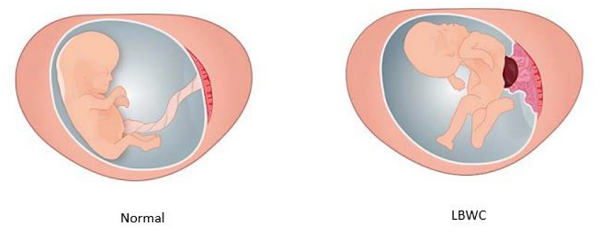This leaflet is to help you understand what Limb Body Wall Complex (LBWC) is, what tests you need, and the implication of being diagnosed for you and your baby.
What is a Limb Body Wall Complex
Limb Body Wall Complex (LBWC) is a serious abnormality where the baby’s organs are outside of the baby’s body and attached to the placenta. The baby is unable to move or grow properly and organs are damaged. LBWC is rare and affects approximately 1:15,000 pregnancies.

The image on the left shows a normal baby and umbilical cord that are freely floating in the amniotic fluid. The baby’s arms and legs are free to move around, and the internal organs are all contained within the body. In the image on the right, the baby has LBWC. The baby’s internal organs have come out through a hole in the belly and the organs have stuck to the placenta and the umbilical cord is very short. Because of the fixed positioning, as the baby continues to grow it develops abnormal posturing of its spine and limbs.
How is LBWC detected?
LBWC is suspected if a short or absent umbilical cord is seen at the time of your ultrasound, if the baby is in a fixed and awkward position throughout the scan or if there appear to be any abnormalities of the face or abdomen.
What causes LBWC?
The cause of LBWC is unknown but it is thought to result from problems in the way the early pregnancy develops. If the embryo doesn’t fold and twist properly, or if there is an interruption in the blood supply to vital organs, this can set off a series of steps that result in severe fetal abnormalities. Most of the time, the baby’s face or organs which are supposed to be in the abdomen are attached to the placenta.
Should I have more tests done?
The diagnosis of LBWC can be made with ultrasound as early as 11-13 weeks using a camera on the mother’s belly. In some cases, the doctor may recommend placing a small ultrasound probe (camera) in the vagina to get additional pictures. Additional tests are typically not necessary.
What are the things to watch for during pregnancy?
Unfortunately, many babies affected by LBWC die before birth. Due to the severity of the problems that these babies have, parents have the option of interrupting the pregnancy if they wish, and if this option is legally available. If parents choose to continue with the pregnancy, further ultrasound examinations are indicated to assess fetal growth and to evaluate the placenta. LBWC has been associated with having a placenta that sticks firmly on the wall of the uterus or sits low and close to the cervix which can place the mother at increased risk of bleeding either during pregnancy or at the time of delivery.
What does it mean for my baby after it is born?
Babies with LBWC who survive to birth may be born alive or may die during the birthing process. Often, the baby is born together with the placenta and the baby may appear quite disfigured at birth. Babies who are born alive may survive for a short while. The team of doctors who will be assisting the baby after delivery may offer some measures to help make the baby more comfortable. You may wish to discuss these measures in advance with the team who will be assisting the baby after delivery. However, even with these efforts most babies will die shortly after birth.
Will it happen again?
It is very unlikely that LBWC will happen again in another pregnancy.
